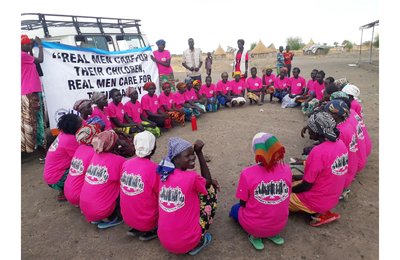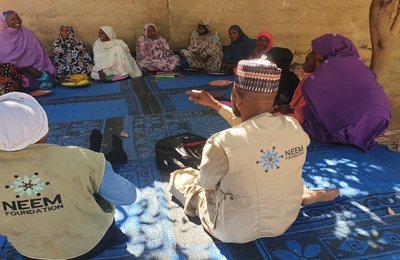Never Again Should Be Never Again: The Jos Peace Wall
The city of Jos, Nigeria, has come a long way since the devastating crisis of September 2001. The conflict left hundreds dead and tens of thousands displaced, exposing deep-seated ethnic and religious divisions. Twenty-three years later, the scars still linger, but a beacon of hope has emerged in the form of the Peace Wall.

Historical and Sociopolitical Factors
To understand the significance of the Peace Wall, it is essential to delve into the historical and sociopolitical factors that contributed to the 2001 crisis. Jos, a city once renowned for its tranquillity and cosmopolitan charm, was vulnerable to tensions simmering beneath the surface.
Colonial legacy and competing interests for resources contributed significantly to the escalation of tensions in Jos, Plateau. During the colonial period, administrative policies often favoured certain ethnic groups and created distinctions between so-called "indigenes" and "settlers." These classifications were later entrenched in governance and resource distribution systems, leading to long-standing grievances.
The indigene-settler divide became particularly contentious, as access to land, political representation, and economic opportunities were often granted based on one's status as an "indigene." This exclusionary dynamic marginalized those classified as "settlers," even if they had lived in the region for generations.
Faith divisions also played a central role, as Plateau State is home to diverse religious communities, predominantly Christians and Muslims. Political actors often exploited these divisions, using religious identity to mobilize support and entrench their influence. Economic factors, including competition for farmland, jobs, and access to public resources, further exacerbated tensions.
These overlapping issues created a volatile environment where minor disputes over land, political appointments, or access to services could spiral into broader communal violence.
The Role of Local Leaders in Fostering Peace and Reconciliation
In the aftermath of the crisis, local leaders recognized the need for collective action to rebuild and reconcile their communities. Through The Tattaaunawa Roundtable, visionary leaders from diverse backgrounds came together to create the Peace Wall, a large white wall, with handwritten messages, a powerful symbol of reconciliation. This Wall now serves as a reminder, both of the city's tumultuous past and its aspirations for a peaceful future.
What is peace?
We asked stakeholders from diverse backgrounds to share their thoughts on what peace means to them. Their responses, inscribed on the Peace Wall, offer a glimpse into the complexities of building harmony in a fractured society.
"Peace is Value." - Deborah (Christian)
"Peace is the ability to accommodate opposite opinion and exhibit tolerance."- Salis Abdulsalam (Muslim)
Voices from the Peace Wall
Representing 39 ethnic groups, 22 languages, and four faiths, stakeholders shared their visions for peace:
"Peace means my children can play freely, without fear of violence." - Mrs. Sarah Pam (Berom)
"Peace is about embracing our diversity, not fighting it." - Mr. Mohammed Sani (Hausa)
“Peace means equal opportunities for all, regardless of tribe or faith." - Dr. John Dung (Tarok)
“Peace begins with you and me” - Aisha Wiggins (Yoruba)
“Peace is humanity” - Mugu Zaka Bako (Southern Kaduna)
“Peace is irreplaceable, imbibe it” -Friday Dewan (Native)
"Peace is understanding." - Hajia Muna Abdul (Fulani)
"Peace is not an option." - L. T Yilwada (Native Plateau)
“Peace is not something you wish for, it is something you make, something you are, something you do, and something you give away” - Hafsat Adam (Fulani)
The Peace Wall's impact
The Peace Wall has had a profound impact on the community. It teaches us that diversity is strength, and that by celebrating our differences we can foster mutual understanding and unity. The Wall's inscriptions reflect the diversity of Jos's population, showing that inclusive dialogue among diverse stakeholders is crucial for conflict resolution. We have also seen increased social cohesion, as the Wall serves as a shared space for people from different ethnic and religious backgrounds to come together.
One particularly impactful activity at the Wall is the "Storytelling Circle." Every other quarter, people from different backgrounds gather by the Wall to share their personal stories, experiences, and perspectives. These stories often touch on themes of conflict, loss, resilience, and hope with a focus on Plateau State. By listening to each other's narratives, community members develop empathy and understanding, breaking down stereotypes and building bridges of connection. The Storytelling Circle looks to ultimately become a powerful symbol of unity and reconciliation, demonstrating that even in a city marked by conflict, shared stories can pave the way for healing and peace.
The Wall has contributed to a significant decrease in violent conflicts, and we know that reconciliation requires effort: Building peace takes time, patience, and collective commitment.
Challenges and opportunities
Despite progress, challenges persist. Tensions still linger due to ongoing ethnic and religious divisions, as well as inequality and poverty.
Opportunities for further progress:
The Wall still provides a space for sustained engagement, continuous dialogue and community outreach. Writings on the Wall serve as a springboard for education and empathy, to encourage understanding different perspectives that can dispel misconceptions. There is an opening for collective responsibility: shared ownership and accountability.
Lessons learned - The way forward
As we reflect on Jos' turbulent past, we recognize that "never again" remains an unfulfilled promise. Yet, the Peace Wall inspires hope along the following priorities:
- Sustained engagement: continuous dialogue and community outreach are vital
- Education and empathy: understanding different perspectives can dispel misconceptions
- Collective responsibility: peacebuilding requires shared ownership and accountability.
Conclusion
The Peace Wall stands as a testament to Jos's resilience and determination. As we strive for a future where "never again" becomes reality, we must:
- Honour the past by learning from it
- Engage in inclusive, continuous dialogue
- Foster empathy and understanding.
Together, we can create a world where peace is not just a distant dream but a lived reality.









